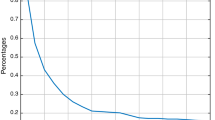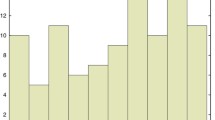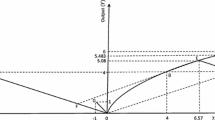Abstract
Directional distance function (DDF) has been a commonly used technique for estimating efficiency and productivity over the past two decades, and the directional vector is usually predetermined in the applications of DDF. The most critical issue of using DDF remains that how to appropriately project the inefficient decision-making unit onto the production frontier along with a justified direction. This paper provides a comprehensive literature review on the techniques for selecting directional vector of the directional distance function. It begins with a brief introduction of the existing methods around the inclusion of the exogenous direction techniques and the endogenous direction techniques. The former commonly includes arbitrary direction and conditional direction techniques, while the latter involves the techniques for seeking theoretically optimized directions (i.e., direction towards the closest benchmark or indicating the largest efficiency improvement potential) and market-oriented directions (i.e., directions towards cost minimization, profit maximization, or marginal profit maximization benchmarks). The main advantages and disadvantages of these techniques are summarized, and the limitations inherent in the exogenous direction-selecting techniques are discussed. It also analytically argues the mechanism of each endogenous direction technique. The literature review is end up with a numerical example of efficiency estimation for power plants, in which most of the reviewed directions for DDF are demonstrated and their evaluation performance are compared.











Similar content being viewed by others
Notes
The hyperbolic efficiency measure (Färe et al. 1989) is excluded in this study since the model does not provide a linear direction vector which can be used in DDF and shows a nonlinear optimization problem.
References
Adler, N., & Voltab, N. (2016). Accounting for externalities and disposability: A directional economic environmental distance function. European Journal of Operational Research, 250, 314–327.
Agee, M. D., Atkinson, S. E., & Crocker, T. D. (2012). Child maturation, time-invariant, and time-varying inputs: Their interaction in the production of child human capital. Journal of Productivity Analysis, 35, 29–44.
Aparicio, J., Ruiz, J. L., & Sirvent, I. (2007). Closest targets and minimum distance to the Pareto-efficient frontier in DEA. Journal of Productivity Analysis, 28, 209–218.
Arabi, B., Munisamy, S., Emrouznejad, A., & Shadman, F. (2014). Power industry restructuring and eco-efficiency changes: A new slacks-based model in Malmquist–Luenberger Index measurement. Energy Policy, 68, 132–145.
Baek, C., & Lee, J. (2009). The relevance of DEA benchmarking information and the least-distance measure. Mathematical and Computer Modelling, 49, 265–275.
Ball, E., Färe, R., Grosskopf, S., & Zaim, O. (2005). Accounting for externalities in the measurement of productivity growth: The Malmquist cost productivity measure. Structural Change and Economic Dynamics, 16(3), 374–394.
Bellenger, M. J., & Herlihy, A. T. (2009). An economic approach to environmental indices. Ecological Economics, 68, 2216–2223.
Chambers, R. G., Chung, Y., & Färe, R. (1996a). Benefit and distance functions. Journal of Economic Theory, 70, 407–419.
Chambers, R., Färe, R., & Grosskopf, S. (1996b). Productivity growth in APEC countries. Pacific Economic Review, 1, 181–190.
Chen, C.-M., & Delmas, M. A. (2012). Measuring eco-inefficiency: A new frontier approach. Operations Research, 60(5), 1064–1079.
Chen, Y., Du, J., & Huo, J. Z. (2013). Super-efficiency based on a modified directional distance function. Omega, 41, 621–625.
Chung, Y., Färe, R., & Grosskopf, S. (1997). Productivity and undesirable outputs: A directional distance function approach. Journal of Environmental Management, 51, 229–240.
Coggins, J. S., & Swinton, J. R. (1996). The price of pollution: A dual approach to valuing \(\text{ SO }_2\) allowances. Journal of Environmental Economics and Management, 30, 58–72.
Cong, R. G., & Wei, Y. M. (2010). Potential impact of (CET) carbon emissions trading on China’s power sector: A perspective from different allowance allocation options. Energy, 35(9), 3921–3931.
Cong, R. G., & Wei, Y. M. (2012). Experimental comparison of impact of auction format on carbon allowance market. Renewable & Sustainable Energy Reviews, 16(6), 4148–4156.
Cooper, W. W., Park, K. S., & Pastor, J. T. (1999). RAM: A range adjusted measure of inefficiency for use with additive models, and relations to other models and measures in DEA. Journal of Productivity Analysis, 11, 5–42.
Dervaux, B., Leleu, H., Minvielle, E., Valdmanis, V., Aegerter, P., & Guidet, B. (2009). Performance of French intensive care units: A directional distance function approach at the patient level. International Journal of Production Economics, 120, 585–594.
Du, L. M., Hanley, A., & Zhang, N. (2016). Environmental technical efficiency, technology gap and shadow price of coal-fuelled power plants in China: A parametric meta-frontier analysis. Resource and Energy Economics, 43, 14–32.
Farrell, M. (1957). The measurement of productive efficiency. Journal of the Royal Statistical Society Series A (General) Part O, 120(3), 253–281.
Färe, R., & Grosskopf, S. (2004). New directions: Efficiency and productivity. Boston: Kluwer Academic Publishers.
Färe, R., & Grosskopf, S. (2010). Directional distance functions and slacks-based measures of efficiency. European Journal of Operational Research, 200, 320–322.
Färe, R., Grosskopf, S., Lovell, C. A. K., & Pasurka, C. (1989). Multilateral productivity comparisons when some outputs are undesirable: A nonparametric approach. Review of Economics and Statistics, 71(1), 90–98.
Färe, R., Grosskopf, S., Noh, D. W., & Weber, W. (2005). Characteristics of a polluting technology: Theory and practice. Journal of Econometrics, 126, 469–492.
Färe, R., Grosskopf, S., & Pasurka, C. (1986). Effects on relative efficiency in electric power generation due to environmental controls. Resources and Energy, 8, 167–184.
Färe, R., Grosskopf, S., & Pasurka, C. (2016). Technical change and pollution abatement cost. European Journal of Operational Research, 248, 715–724.
Färe, R., Grosskopf, S., & Pasurka, C. A. (2007). Environmental production functions and environmental directional distance functions. Energy, 32, 1055–1066.
Färe, R., Grosskopf, S., Pasurka, C. A., & Weber, W. (2012). Substitutability among undesirable outputs. Applied Economics, 44, 39–47.
Färe, R., Grosskopf, S., & Weber, W. L. (2006). Shadow prices and pollution costs in U.S. agriculture. Ecological Economics, 56, 89–103.
Färe, R., Grosskopf, S., & Wittaker, G. (2013). Directional output distance functions: Endogenous constraints based on exogenous normalization constraints. Journal of Productivity Analysis, 40, 267–269.
Färe, R., & Logan, J. (1992). The rate of return regulated version of Farrell efficiency. International Journal of Production Economics, 27(2), 161–165.
Färe, R., & Primont, D. (1995). Multi-output production and duality: Theory and applications. Boston: Kluwer Academic Publishers.
Frei, F. X., & Harker, P. T. (1999). Projections onto efficient frontiers: Theoretical and computational extensions to DEA. Journal of Productivity Analysis, 11, 275–300.
Fukuyama, H., & Weber, W. L. (2009). A directional slacks-based measure of technical inefficiency. Socio-Economic Planning Sciences, 43, 274–287.
Granderson, G., & Prior, D. (2013). Environmental externalities and regulation constrained cost productivity growth in the US electric utility industry. Journal of Productivity Analysis, 39, 243–257.
Halkos, G. E., & Tzeremes, N. G. (2013). A conditional directional distance function approach for measuring regional environmental efficiency: Evidence from UK regions. European Journal of Operational Research, 227, 182–189.
Hampf, B., & Krüger, J. J. (2014a). Optimal directions for directional distance functions: An exploration of potential reductions of greenhouse gases. American Journal of Agricultural Economics, 97, 920–938.
Hampf, B., & Kruger, J. J. (2014b). Technical efficiency of automobiles—A nonparametric approach incorporating carbon dioxide emissions. Transportation Research Part D, 33, 47–62.
Hailu, A., & Chambers, R. G. (2012). A Luenberger soil quality indicator. Journal of Productivity Analysis, 38(2), 145–154.
Kumar, S. (2006). Environmentally sensitive productivity growth: A global analysis using Malmquist-Luenberger index. Ecological Economics, 56, 280–293.
Kuosmanen, T. (2005). Weak disposability in nonparametric productivity analysis with undesirable outputs. American Journal of Agricultural Economics, 87(4), 1077–1082.
Lee, C.-Y. (2014). Meta-data envelopment analysis: Finding a direction towards marginal profit maximization. European Journal of Operational Research, 237, 207–216.
Lee, C.-Y. (2016). Nash-profit efficiency: A measure of changes in market structures. European Journal of Operational Research, 255, 659–663.
Lee, C.-Y., & Johnson, A. L. (2015). Measuring efficiency in imperfectly competitive markets: An example of rational inefficiency. Journal of Optimization Theory and Applications, 164(2), 702–722.
Lee, J., Park, J., & Kim, T. (2002). Estimation of the shadow prices of pollutants with production/environment inefficiency taken into account: A nonparametric directional distance function approach. Journal of Environmental Management, 64, 365–375.
Leleu, H. (2013). Shadow pricing of undesirable outputs in nonparametric analysis. European Journal of Operational Research, 231, 474–480.
Luenberger, D. G. (1992). New optimality principle for economic efficiency and equilibrium. Journal of Optimization Theory and Applications, 75(2), 221–264.
Macpherson, A. J., Principe, P. P., & Smith, E. R. (2010). A directional distance function approach to regional environmental-economic assessments. Ecological Economics, 69, 1918–1925.
Matsushita, K., & Yamane, F. (2012). Pollution from the electric power sector in Japan and efficient pollution reduction. Energy Economics, 34, 1124–1130.
Murty, S., Russell, R. R., & Levkoff, S. B. (2012). On modeling pollution-generating technologies. Journal of Environmental Economics and Management, 64, 117–135.
Njuki, E., & Bravo-Ureta, B. E. (2015). The economic costs of environmental regulation in U.S. dairy farming: A directional distance function approach. American Journal of Agricultural Economics, 97(4), 1087–1106.
Oh, D. (2010). A global Malmquist–Luenberger productivity index. Journal of Productivity Analysis, 34, 183–197.
Oum, T. H., Pathomsiri, S., & Yoshida, S. (2013). Limitations of DEA-based approach and alternative methods in the measurement and comparison of social efficiency across firms in different transport modes: An empirical study in Japan. Transportation Research Part E, 57, 16–26.
Pathomsiri, S., Haghani, A., Dresner, M., & Windle, R. J. (2008). Impact of undesirable outputs on the productivity of US airports. Transportation Research Part E, 44, 235–259.
Picazo-Tadeo, A. J., Beltrán-Esteve, M., & Gómez-Limón, J. A. (2012). Assessing eco-efficiency with directional distance functions. European Journal of Operational Research, 220, 798–809.
Picazo-Tadeo, A. J., & Prior, D. (2009). Environmental externalities and efficiency measurement. Journal of Environmental Management, 90, 3332–3339.
Picazo-Tadeo, A. J., Reig-Martínez, E., & Hernández-Sancho, F. (2005). Directional distance functions and environmental regulation. Resource Energy Economics, 27, 131–142.
Podinovski, V. V., & Førsund, F. R. (2010). Differential characteristics of efficient frontiers in data envelopment analysis. Operations Research, 58(6), 1743–1754.
Portela, M., Borges, P. C., & Thanassoulis, E. (2003). Finding closest targets in non-oriented DEA models: The case of convex and non-convex technologies. Journal of Productivity Analysis, 19, 251–269.
Ray, S. C., Chen, L., & Mukherjee, K. (2008). Input price variation across locations and a generalized measure of cost efficiency. International Journal of Production Economics, 116, 208–218.
Ray, S. C., & Mukherjee, K. (2000). Decomposition of cost competitiveness in US manufacturing: Some state by state comparisons. Indian Economic Review, 35, 133–153.
Rezek, J. P., & Campbell, R. C. (2007). Cost estimates for multiple pollutants: A maximum entropy approach. Energy Economics, 29, 503–519.
Shephard, R. W. (1970). Theory of cost and production functions. Princeton, NJ: Princeton University Press.
Simar, L., Vanhems, A., & Wilson, P. W. (2012). Statistical inference for DEA estimators of directional distances. European Journal of Operational Research, 220, 853–864.
Vardanyan, M., & Noh, D. W. (2006). Approximating pollution abatement costs via alternative specifications of a multi-output production technology: A case of the U.S. electric utility industry. Journal of Environmental Management, 80, 177–190.
Wang, K., & Wei, Y. M. (2016). Sources of energy productivity change in China during 1997–2012: A decomposition analysis based on the Luenberger productivity indicator. Energy Economics, 54, 50–59.
Wang, K., Wei, Y. M., & Zhang, X. (2012). A comparative analysis of China’s regional energy and emission performance: Which is the better way to deal with undesirable outputs? Energy Policy, 46, 574–584.
Wang, K., Wei, Y. M., & Zhang, X. (2013). Energy and emissions efficiency patterns of Chinese regions: A multi-directional efficiency analysis. Applied Energy, 104, 105–116.
Wang, K., Xian, Y., Wei, Y. M., & Huang, Z. (2016). Sources of carbon productivity change: A decomposition and disaggregation analysis based on global Luenberger productivity indicator and endogenous directional distance function. Ecological Indicators, 66, 545–555.
Watanabe, M., & Tanaka, K. (2007). Efficiency analysis of Chinese industry: A directional distance function approach. Energy Policy, 35, 6323–6331.
Zhou, P., Ang, B. W., & Wang, H. (2012). Energy and CO\(_2\) emission performance in electricity generation: A non-radial directional distance function approach. European Journal of Operational Research, 221, 625–635.
Zofio, J. L., Paster, J. T., & Aparicio, J. (2013). The directional profit efficiency measure: On why profit efficiency is either technical or allocative. Journal of Productivity Analysis, 40(3), 257–266.
Acknowledgements
We gratefully acknowledge the financial support from the National Natural Science Foundation of China (Grant Nos. 71471018, 71521002, and 71642004), the Joint Development Program of Beijing Municipal Commission of Education, the Social Science Foundation of Beijing (Grant No. 16JDGLB013), the National Key R&D Program (Grant No. 2016YFA0602603), and the Ministry of Science and Technology of Taiwan (MOST103-2221-E-006-122-MY3).
Author information
Authors and Affiliations
Corresponding author
Rights and permissions
About this article
Cite this article
Wang, K., Xian, Y., Lee, CY. et al. On selecting directions for directional distance functions in a non-parametric framework: a review. Ann Oper Res 278, 43–76 (2019). https://doi.org/10.1007/s10479-017-2423-5
Published:
Issue Date:
DOI: https://doi.org/10.1007/s10479-017-2423-5




